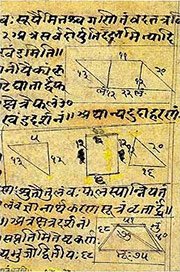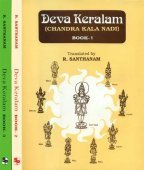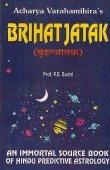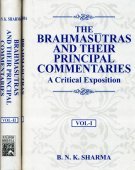Amsha, Aṃsa, Aṃśa, Amsa: 41 definitions
Introduction:
Amsha means something in Buddhism, Pali, Hinduism, Sanskrit, the history of ancient India, Marathi, Jainism, Prakrit, Hindi. If you want to know the exact meaning, history, etymology or English translation of this term then check out the descriptions on this page. Add your comment or reference to a book if you want to contribute to this summary article.
The Sanskrit term Aṃśa can be transliterated into English as Amsa or Amsha, using the IAST transliteration scheme (?).
Alternative spellings of this word include Ansh.
Images (photo gallery)
In Hinduism
Purana and Itihasa (epic history)
Source: archive.org: Puranic EncyclopediaAṃśa (अंश).—A sage of the family of Marīci. Genealogy. He was descended from Viṣṇu through Brahmā, Marīci and Kaśyapa. Birth. Marīci was one of the six sons, all ṛṣis, of Brahmā. These six sons, born parthogenetically of Brahmā, were: Marīci, Aṅgiras, Atri, Pulastya, Pulaha and Kratu. Marīci had a son named Kaśyapa. Kaśyapa married the thirteen daughters of Dakṣa. The eldest of them, Aditi, gave birth to twelve sons Dhātā, Aryaman, Mitra, Śakra, Varuṇa, Aṃśa, Bhaga, Vivasvān, Pūṣan, Savitā, Tvaṣṭā and Viṣṇu. Aṃśa is one of these twelve sons who have been called the twelve Ādityas. (See Chapter 65 of Ādi Parva of the Mahābhārata). Events. The Mahābhārata says (Śloka 66, Chapter 123) that Aṃśa was present at the time of Arjuna’s birth when several devas had come there to see the infant. In Śloka 34, Chapter 45 of Śalya Parva it is said that Aṃśa was present on the occasion of the Abhiṣeka of Skandadeva. Aṃśa is said to have presented to Skandadeva five good warriors: Parigha, Vaṭa, Bhīma, Dahana and Dahati. (See full article at Story of Aṃśa from the Puranic encyclopaedia by Vettam Mani)
Source: Cologne Digital Sanskrit Dictionaries: The Purana Index1a) Aṃśa (अंश).—Name of a god with the Hemanta sun; a Tuṣita god.*
- * Brahmāṇḍa-purāṇa II. 23. 16; 36. 11.
1b) An Āditya.*
- * Vāyu-purāṇa 66. 66; Viṣṇu-purāṇa I. 15. 131.
1c) The Rākṣasa who resides in the sun's chariot during the month of Mārgaśīrṣa.*
- * Viṣṇu-purāṇa II. 10. 13.
Aṃśa (अंश) is a name mentioned in the Mahābhārata (cf. I.59.15, I.65, IX.44.5) and represents one of the many proper names used for people and places. Note: The Mahābhārata (mentioning Aṃśa) is a Sanskrit epic poem consisting of 100,000 ślokas (metrical verses) and is over 2000 years old.
Source: Shodhganga: The saurapurana - a critical studyAṃśa (अंश) is the name of one of the twelve Ādityas: the offspring of Aditi, according to one account of Vaṃśa (‘genealogical description’) of the 10th century Saurapurāṇa: one of the various Upapurāṇas depicting Śaivism.—Accordingly, Dakṣa gave thirteen daughters to Kaśyapa. [...] Kaśyapa’s thirteen wives are [viz., Aditi]. Aditi gives birth to twelve Ādityas, [viz. Aṃśa].

The Purana (पुराण, purāṇas) refers to Sanskrit literature preserving ancient India’s vast cultural history, including historical legends, religious ceremonies, various arts and sciences. The eighteen mahapuranas total over 400,000 shlokas (metrical couplets) and date to at least several centuries BCE.
Shilpashastra (iconography)
Source: Wisdom Library: Śilpa-śāstraAṃśa (अंश, “part”) refers to the “parts” (decorative mouldings) of an adhiṣṭhāna (pedestal or base of a structure) or an upapīṭha (sub-structure, beneath the adhiṣṭhāna).

Shilpashastra (शिल्पशास्त्र, śilpaśāstra) represents the ancient Indian science (shastra) of creative arts (shilpa) such as sculpture, iconography and painting. Closely related to Vastushastra (architecture), they often share the same literature.
Natyashastra (theatrics and dramaturgy)
Source: Wisdom Library: Nāṭya-śāstraAṃśa (अंश, “part”) refers to the “governing note” or the “key-note” in Indian music, and is one of the ten characteristics (gati) of the jāti (melodic class), according to the Nāṭyaśāstra chapter 28. It is also known as aṃśagati or aṃśasvara. Jāti refers to a recognized melody-type and can be seen as a precursor to rāgas which replaced them.
According to the Nāṭyaśāstra 28.76-78, “the aṃśa is that note in the song on which its charm (rāga) depends, and from which the charm proceeds; it is the basis of the variation into low (mandra) and high (tāra) pitches depending on the first five notes (pañcasvarapara), and in the combination of many notes it is perceived prominently (atyartham), and moreover other strong notes may be to it in relation of consonance and assonance, and it is related to the graha, apanyāsa, vinyāsa, saṃnyāsa and nyāsa notes (svara), and it lies scattered throughout the song”.

Natyashastra (नाट्यशास्त्र, nāṭyaśāstra) refers to both the ancient Indian tradition (shastra) of performing arts, (natya—theatrics, drama, dance, music), as well as the name of a Sanskrit work dealing with these subjects. It also teaches the rules for composing Dramatic plays (nataka), construction and performance of Theater, and Poetic works (kavya).
Vastushastra (architecture)
Source: McGill: The architectural theory of the MānasāraAṃśa (अंश, “part”) refers to the (alternate) sixth of āyādiṣaḍvarga, six principles that constitute the “horoscope” of an architectural or iconographic object, according to the Mānasāra (IX, 63-73). Their application is intended to “verify” the measurements of the architectural and iconographic object against the dictates of astrology that lay out the conditions of auspiciousness.
Aṃśa, “part”, sometimes presented as the alternate to tithi, is nine in number. The Mānasāra does not give a full list of them. According to the Mayamata, they are:
- taskara, “thief”;
- bhukti, “enjoyment”;
- śakti, “power”;
- dhana, “wealth”;
- rāja / rājan, “king”;
- ṣaṇḍa, “eunuch”;
- abhaya, “absence of fear” (or “refuge”);
- vipat, “adversity”;
- samṛddhi, “success”.
The Mayamata states that among these, taskara, ṣaṇḍa and vipat are inauspicious, and therefore to be avoided.
Source: OpenEdition books: Architectural terms contained in Ajitāgama and RauravāgamaAṃśa (अंश) refers to “- 1. equal part (in the calculation of proportions) § 2.2 . — 2. = paṅkti (Rau) § 2.3. — 3. = Dehalabdhāṅgula § 2.4. - 4. name of one of the āyādi formulas § 2.7.”.—(For paragraphs cf. Les enseignements architecturaux de l'Ajitāgama et du Rauravāgama by Bruno Dagens)

Vastushastra (वास्तुशास्त्र, vāstuśāstra) refers to the ancient Indian science (shastra) of architecture (vastu), dealing with topics such architecture, sculpture, town-building, fort building and various other constructions. Vastu also deals with the philosophy of the architectural relation with the cosmic universe.
Jyotisha (astronomy and astrology)
Source: Wisdom Library: Brihat Samhita by VarahamihiraAmśa (अम्श) refers to a “section” (of the firmament), according to the Bṛhatsaṃhitā (chapter 5), an encyclopedic Sanskrit work written by Varāhamihira mainly focusing on the science of ancient Indian astronomy astronomy (Jyotiṣa).—Accordingly, “If the sun and moon should begin to be eclipsed when only half risen, deceitful men will suffer as well as sacrificial rites. If they should be eclipsed when in the first section of the firmament, those that live by fire and virtuous Brahmins will suffer as well as men belonging to one of the holy orders. If they should be eclipsed when in the second section of the firmament, agriculturists, heretics, merchants, the Kṣatriyas and commanders of the army will suffer. If when in the third section [i.e., kha-amśa—khatṛtīyāṃśe], artisans, the Śūdras, the Mlecchas and ministers will suffer”.
Source: Wikibooks (hi): Sanskrit Technical TermsAṃśa (अंश).—1. Degree. 2. Part. 3. An upper vertex of a quadrilateral. Note: Aṃśa is a Sanskrit technical term used in ancient Indian sciences such as Astronomy, Mathematics and Geometry.

Jyotisha (ज्योतिष, jyotiṣa or jyotish) refers to ‘astronomy’ or “Vedic astrology” and represents the fifth of the six Vedangas (additional sciences to be studied along with the Vedas). Jyotisha concerns itself with the study and prediction of the movements of celestial bodies, in order to calculate the auspicious time for rituals and ceremonies.
Vaishnavism (Vaishava dharma)
Source: Pure Bhakti: Bhagavad-gita (4th edition)Aṃśa (अंश) refers to “portion, or expansion, of Śrī Kṛṣṇa”. (cf. Glossary page from Śrīmad-Bhagavad-Gītā).
Source: Pure Bhakti: Brhad BhagavatamrtamAṃśa (अंश) refers to:—A portion; an expansion of the Lord. (cf. Glossary page from Śrī Bṛhad-bhāgavatāmṛta).

Vaishnava (वैष्णव, vaiṣṇava) or vaishnavism (vaiṣṇavism) represents a tradition of Hinduism worshipping Vishnu as the supreme Lord. Similar to the Shaktism and Shaivism traditions, Vaishnavism also developed as an individual movement, famous for its exposition of the dashavatara (‘ten avatars of Vishnu’).
Ayurveda (science of life)
Source: gurumukhi.ru: Ayurveda glossary of termsAṃsa (अंस):—[aṃsaḥ] Shoulder

Āyurveda (आयुर्वेद, ayurveda) is a branch of Indian science dealing with medicine, herbalism, taxology, anatomy, surgery, alchemy and related topics. Traditional practice of Āyurveda in ancient India dates back to at least the first millenium BC. Literature is commonly written in Sanskrit using various poetic metres.
Shaivism (Shaiva philosophy)
Source: Brill: Śaivism and the Tantric TraditionsAṃśa (अंश) refers to a “portion (of one’s karma)”, according to the Svacchandatantra verse 4.79b-81b.—Accordingly, “The Sādhaka is of two kinds. On the one hand, there is the śivadharmī, for whom the cosmic path is purified by Śaiva mantras and who is yoked to [particular] mantras that are to be mastered; he is knowledgeable, consecrated [to office], and devoted to the propitiation of mantras. This Śaiva Sādhaka is capable [of mastering] the threefold supernatural powers. The second [kind of Sādhaka] adheres to the mundane path and is devoted to the performance of good and meritorious works; desiring the fruits produced by [his] karma, he abides solely [devoted to] meritorious [karma], free of the unmeritorious. [The Guru] should always perform the destruction of the unmeritorious portion (aśubha-aṃśa-vināśana) [of the candidate’s karma] with mantras”.

Shaiva (शैव, śaiva) or Shaivism (śaivism) represents a tradition of Hinduism worshiping Shiva as the supreme being. Closely related to Shaktism, Shaiva literature includes a range of scriptures, including Tantras, while the root of this tradition may be traced back to the ancient Vedas.
Ganitashastra (Mathematics and Algebra)
Source: archive.org: Hindu MathematicsAṃśa (अंश) or Bhāga refers to a “unit fraction” in Bhinna (“fractions”), which refers to one of the twenty operations (logistics) of pāṭīgaṇita (“science of calculation which requires the use of writing material—the board”), according to Pṛthudakasvāmī’s commentary on the Brāhmasphuṭasiddhānta by Brahmagupta, a Sanskrit treatise on ancient Indian mathematics (gaṇita-śāstra) and astronomy from the 7th century.—In the Śulba, unit fractions are denoted by the use of a cardinal number with the term bhāga or aṃśa; thus pañcadaśa-bhāga (“fifteen-parts”) is equivalent to one-fifteenth, sapta-bhāga (“seven-parts”) is equivalent to one-seventh, and so on. The use of ordinal numbers with the term bhāga or aṃśa is also quite common, e.g., pañcama-bhāga (“fifth part”) is equivalent to one-fifth. [...] The present method of expressing fractions is thus derived from Hindu sources and can be traced back to 3,000 B.C.

Ganitashastra (शिल्पशास्त्र, gaṇitaśāstra) refers to the ancient Indian science of mathematics, algebra, number theory, arithmetic, etc. Closely allied with astronomy, both were commonly taught and studied in universities, even since the 1st millennium BCE. Ganita-shastra also includes ritualistic math-books such as the Shulba-sutras.
Gitashastra (science of music)
Source: Shodhganga: Elements of Art and Architecture in the Trtiyakhanda of the Visnudharmottarapurana (gita)Aṃśa (अंश) refers to one of the thirteen Jātis or “proper combination of two grāmas” (in Indian music), according to the Kallinātha’s commentary Kalānidhi on the Saṃgītaratnākara.—In the Nāṭyaśāstra, jātis are broadly divided into two types viz., śuddhā and vikṛtā. The Saṃgītaratnākara also agrees on it. But in the Viṣṇudharmottarapurāṇa, the reference about the types of jātis is not found. The Saṃgītaratnākara accepts thirteen kinds of characteristic features of jātis. For example: Aṃśa, which is also accepted by the Nāṭyaśāstra.
Gitashastra (गीतशास्त्र, gītaśāstra) refers to the ancient Indian science of Music (gita or samgita), which is traditionally divided in Vocal music, Instrumental music and Dance (under the jurisdiction of music). The different elements and technical terms are explained in a wide range of (often Sanskrit) literature.
Yoga (school of philosophy)
Source: ORA: Amanaska (king of all yogas): A Critical Edition and Annotated Translation by Jason BirchAṃśa (अंश) refers to a “portion (of consciousness)”, according to the Amanaska Yoga treatise dealing with meditation, absorption, yogic powers and liberation.—Accordingly, as Īśvara says to Vāmadeva: “[...] In sleep, a portion of consciousness (cid-aṃśa) is lost [svapne cidaṃśaśūnyatvaṃ] and in wakefulness, there is grasping at sense objects. The wise know that there is an inner reality beyond sleep and wakefulness. The knowers of the highest reality know that the highest reality is beyond the duality of existence and non-existence, passes beyond [both] sleep and waking and is free from dying and living. [...]”.

Yoga is originally considered a branch of Hindu philosophy (astika), but both ancient and modern Yoga combine the physical, mental and spiritual. Yoga teaches various physical techniques also known as āsanas (postures), used for various purposes (eg., meditation, contemplation, relaxation).
Shaktism (Shakta philosophy)
Source: Google Books: ManthanabhairavatantramAṃśa (अंश) refers to the “fifty limbs (Bhairava), according to the Kularatnoddyota, one of the earliest Kubjikā Tantras.—The first half of chapter nine recounts the various incarnations of the goddess and the god (mūrti-aṃśa-saṃbhūti) in this and preceding aeons and ages. The second half goes on to deal with the relationship between the teachers. [...] These Siddhas are the fifty limbs (aṃśa) of Bhairava. Ranging from Śrīkaṇṭha to Saṃvarta, they are the Bhairavas who govern the letters, arranged here in three ‘lineages’. They follow the deity’s will and are destined to bring the Paścima Kula down to earth and grace the beings who reside in the Śiva principle. [...]

Shakta (शाक्त, śākta) or Shaktism (śāktism) represents a tradition of Hinduism where the Goddess (Devi) is revered and worshipped. Shakta literature includes a range of scriptures, including various Agamas and Tantras, although its roots may be traced back to the Vedas.
General definition (in Hinduism)
Source: Apam Napat: Indian MythologyAmsha is the God of luck, one of the Adityas. He is the son of Aditi and sage Kashyapa. He is invoked together with his brothers, Mitra and Varuna.
In Buddhism
Mahayana (major branch of Buddhism)
Source: Wisdom Library: Maha Prajnaparamita SastraAṃsa (अंस, “shoulder”) refers to that part of the human body from which the Buddha emitted numerous rays when he smiled with his whole body after contemplating the entire universe, according to the 2nd century Mahāprajñāpāramitāśāstra (chapter XIV).—Accordingly, having himself arranged the lion-seat, the Bhagavat sat down cross-legged; holding his body upright and fixing his attention, he entered into the samādhirājasamādhi. Then, having tranquilly come out of this samādhi and having contemplated the entire universe with his divine eye (divyacakṣus), the Bhagavat smiled with his whole body. Wheels with a thousand spokes imprinted on the soles of his feet (pādatala) shoot out six hundred prabhedakoṭi of rays. In the same way, beams of six hundred prabhedakoṭi of rays are emitted from his shoulders (aṃsa).
Source: De Gruyter: A Buddhist Ritual Manual on AgricultureAṃsa (अंस) refers to the “shoulders”, according to the Vajratuṇḍasamayakalparāja, an ancient Buddhist ritual manual on agriculture from the 5th-century (or earlier), containing various instructions for the Sangha to provide agriculture-related services to laypeople including rain-making, weather control and crop protection.—Accordingly, [after the Bhagavān entered the assembly of Nāgas], “Then the great Nāga king Samantākāracchatrākaraparikara arose from his seat, arranged his outer robe on one shoulder (eka-aṃsa), placed his right knee on the ground, approached the Bhagavān and, having bowed down at his feet, circumambulated him three times, and worshipped the Bhagavān with different flowers, fragrances, garlands, ointments, ornaments and cloths. Having worshipped him, he sat down in front of him”.

Mahayana (महायान, mahāyāna) is a major branch of Buddhism focusing on the path of a Bodhisattva (spiritual aspirants/ enlightened beings). Extant literature is vast and primarely composed in the Sanskrit language. There are many sūtras of which some of the earliest are the various Prajñāpāramitā sūtras.
Tibetan Buddhism (Vajrayana or tantric Buddhism)
Source: Wisdom Library: Tibetan BuddhismAṃśa (अंश) is the name of a Pratyekabuddha mentioned as attending the teachings in the 6th century Mañjuśrīmūlakalpa: one of the largest Kriyā Tantras devoted to Mañjuśrī (the Bodhisattva of wisdom) representing an encyclopedia of knowledge primarily concerned with ritualistic elements in Buddhism. The teachings in this text originate from Mañjuśrī and were taught to and by Buddha Śākyamuni in the presence of a large audience (including Aṃśa).

Tibetan Buddhism includes schools such as Nyingma, Kadampa, Kagyu and Gelug. Their primary canon of literature is divided in two broad categories: The Kangyur, which consists of Buddha’s words, and the Tengyur, which includes commentaries from various sources. Esotericism and tantra techniques (vajrayāna) are collected indepently.
India history and geography
Source: Cologne Digital Sanskrit Dictionaries: Indian Epigraphical GlossaryAṃśa.—a small territorial unit (Ep. Ind., Vol. XV, p. 297, text line 26). Note: aṃśa is defined in the “Indian epigraphical glossary” as it can be found on ancient inscriptions commonly written in Sanskrit, Prakrit or Dravidian languages.

The history of India traces the identification of countries, villages, towns and other regions of India, as well as mythology, zoology, royal dynasties, rulers, tribes, local festivities and traditions and regional languages. Ancient India enjoyed religious freedom and encourages the path of Dharma, a concept common to Buddhism, Hinduism, and Jainism.
Languages of India and abroad
Pali-English dictionary
Source: BuddhaSasana: Concise Pali-English Dictionaryaṃsa : (m.; nt.) 1. a part; a side; 2. shoulder.
Source: Sutta: The Pali Text Society's Pali-English Dictionary1) Aṃsa, 2 (see next) point, corner, edge; freg. in combination with numerals, e. g. catur° four-cornered, chaḷ°, aṭṭh°, soḷas° etc. (q. v.) all at Dhs.617 (cp. DhsA.317). In connection with a Vimāna: āyat° with wide or protruding capitals (of its pillars) Vv 8415; as part of a carriagepole Vv 642 (= kubbara-phale patiṭṭhitā heṭṭhima-aṃsā VvA.265). (Page 1)
2) Aṃsa, 1 (Vedic aṃsa; cp. Gr. w)μos, Lat. umerus, Goth ams, Arm. us) (a) the shoulder A v. 110; Sn.609. aṃse karoti to put on the shoulder, to shoulder J.I, 9. (b.) a part (lit. side) (cp. °āsa in koṭṭhāsa and explanation of aṃsa as koṭṭhāsa at DA.I, 312, also v. l. mettāsa for mettaṃsa at It.22). — atīt’aṃse in former times, formerly D.II, 224; Th.2, 314. mettaṃsa sharing friendship (with) A.IV, 151 = It.22 = J.IV, 71 (in which connection Miln.402 reads ahiṃsā). — Disjunctive ekena aṃsena . . . ekena aṃsena on the one hand (side) . . . on the other, partly . . . partly A.I, 61. From this: ekaṃsa (adj.) on the one hand (only), i. e. incomplete (opp. ubhayaṃsa) or (as not admitting of a counterpart) definite, certain, without doubt (opp. dvidhā): see ekaṃsa. — paccaṃsena according to each one’s share A.III, 38. puṭaṃsena with a knapsack for provisions D.I, 117; A II 183; cp. DA.I, 288, with v. l. puṭosena at both passages.

Pali is the language of the Tipiṭaka, which is the sacred canon of Theravāda Buddhism and contains much of the Buddha’s speech. Closeley related to Sanskrit, both languages are used interchangeably between religions.
Marathi-English dictionary
Source: DDSA: The Molesworth Marathi and English Dictionaryaṃśa (अंश).—m (S) A part, portion, piece, share. This word is freely and elegantly used in comp. and, it may appear to the learner, with some variation of sense. As none of its combinations can be inserted in order the following examples should be studied. Ex. jalāṃśa, pittāṃśa, jvarāṃśa, arthāṃśa, mṛttikāṃśa,annāṃśa, ārdrāṃśa, dhānyāṃśa The water-portion or the (specified or mentioned) quantity of water &c. &c. 2 Remaining influence or effect; remains or remnant of. Ex. kēḷīṃ khāllīṃ tara tyāñcā aṃśa phāra vēḷa rāhatō. 3 A degree of latitude or longitude; a degree generally or 1&2044;360th of a circle. 4 In arith. and alg. A fraction: also the numerator of a fraction. 5 Shoulder-blade.
Source: DDSA: The Aryabhusan school dictionary, Marathi-Englishaṃśa (अंश).—m A part, a fraction, remnant of. A degree
--- OR ---
āṃsa (आंस).—m An axle.
Marathi is an Indo-European language having over 70 million native speakers people in (predominantly) Maharashtra India. Marathi, like many other Indo-Aryan languages, evolved from early forms of Prakrit, which itself is a subset of Sanskrit, one of the most ancient languages of the world.
Sanskrit dictionary
Source: DDSA: The practical Sanskrit-English dictionaryAṃśa (अंश).—[aṃś-ac]
1) A share, part, portion, division; member; सकृदंशो निपतति (sakṛdaṃśo nipatati) Manusmṛti 9.47; तुर्यांशः (turyāṃśaḥ) a fourth part; षष्ठ° (ṣaṣṭha°); ममैवांशो जीवलोके जीवभूतः सनातनः (mamaivāṃśo jīvaloke jīvabhūtaḥ sanātanaḥ) Bhagavadgītā (Bombay) 15.7; भुवमंशाविव धर्मयोर्गतौ (bhuvamaṃśāviva dharmayorgatau) R.8.16; अंशेन दर्शितानुकूलता (aṃśena darśitānukūlatā) K.159 partly.
2) A share in property, inheritance; स्वतोंऽशतः (svatoṃ'śataḥ) Manusmṛti 8.48; अनंशौ क्लीबपतितौ (anaṃśau klībapatitau) 9.21; पत्न्यः कार्याः समांशिकाः (patnyaḥ kāryāḥ samāṃśikāḥ) Y.2.115.
3) the numerator of a fraction; अन्योन्यहाराभिहतौ हरांशौ (anyonyahārābhihatau harāṃśau) Līlā.; sometimes used for fraction itself.
4) A degree of latitude (or longitude); अक्षस्यांशाः समाख्याताः षष्टयुत्तरशतत्रयम् (akṣasyāṃśāḥ samākhyātāḥ ṣaṣṭayuttaraśatatrayam); स च अंशः षष्टिकलात्मकः, कला तु षष्टिविकलात्मिका (sa ca aṃśaḥ ṣaṣṭikalātmakaḥ, kalā tu ṣaṣṭivikalātmikā)
5) The shoulder (more correctly written as aṃsa, q. v.).
6) Name of one of the Ādityas; Mahābhārata (Bombay) 1.227.25; cf. also the beginning of T. Ā. The senses of 'party', 'a share of booty', 'earnest money', which are said to occur in the Veda are traceable to 1 above.
7) The vital note in a Rāga.
Derivable forms: aṃśaḥ (अंशः).
--- OR ---
Aṃsa (अंस).—[aṃs karmabhāvādau ac]
1) A part, portion; See अंशः (aṃśaḥ).
2) The shoulder, shoulder-blade; यदयं रथसंक्षोभादंसेनांसो रथोपमश्रोण्याः (yadayaṃ rathasaṃkṣobhādaṃsenāṃso rathopamaśroṇyāḥ) V.1.13.
3) Name of a prince. (-sau) The two angles of an altar [cf. Goth. amsa; L. ansa, humerus; Gr. omor.]
Derivable forms: aṃsaḥ (अंसः).
Source: Cologne Digital Sanskrit Dictionaries: Shabda-Sagara Sanskrit-English DictionaryAṃśa (अंश).—m.
(-śaḥ) 1. A share or portion. 2. A part. 3. A shoulder, the shoulder blade. 4. (In arithmetic) a fraction. 5. The numerator of a fraction. 6 A degree of latitude or longitude, &c. See aṃsa. E. aṃśa to divide, ac affix.
--- OR ---
Aṃsa (अंस).—m.
(-saḥ) 1. A shoulder, a scapula. 2. A part, a portion. E. aṃsa to divide, ac aff. it is also written aṃśa.
Source: Cologne Digital Sanskrit Dictionaries: Benfey Sanskrit-English DictionaryAṃśa (अंश).—rarely aṃsa, m. 1. A part, a share. 2. Booty. 3. Inheritance, [Mānavadharmaśāstra] 9, 47. 4. See aṃsa.
--- OR ---
Aṃsa (अंस).—also aṃśa aṃśa, probably from am (originally, To be strong), m. and n. The shoulder.
— Cf. [Gothic.] amsa; [Latin] humerus and ansa.
Source: Cologne Digital Sanskrit Dictionaries: Cappeller Sanskrit-English DictionaryAṃśa (अंश).—[masculine] portion, share, part, party; [Name] of a god.
--- OR ---
Aṃsa (अंस).—[masculine] shoulder.
Source: Cologne Digital Sanskrit Dictionaries: Monier-Williams Sanskrit-English Dictionary1) Aṃśa (अंश):—m. (probably [from] √1. aś, perf. ān-aṃśa, and not from the above √aṃś fictitiously formed to serve as root), a share, portion, part, party
2) partition, inheritance
3) a share of booty
4) earnest money
5) stake (in betting), [Ṛg-veda v, 86, 5; Tāṇḍya-brāhmaṇa]
6) a lot (cf. 2. prās)
7) the denominator of a fraction
8) a degree of latitude or longitude
9) a day, [cf. Lexicographers, esp. such as amarasiṃha, halāyudha, hemacandra, etc.]
10) Name of an Āditya.
11) Aṃsa (अंस):—[from aṃs] m. the shoulder, shoulder-blade
12) [v.s. ...] corner of a quadrangle
13) [v.s. ...] Name of a king
14) [v.s. ...] m. [dual number] the two shoulders or angles of an altar
15) [v.s. ...] a share (for aṃśa);
16) [v.s. ...] cf. [Gothic] amsa; [Greek] ὦμος, ἄσιλλα; [Latin] humerus, ansa.
17) Āṃśa (आंश):—m. a descendant of Aṃśa [commentator or commentary] on [Uṇādi-sūtra v, 21.]
Source: Cologne Digital Sanskrit Dictionaries: Goldstücker Sanskrit-English DictionaryAṃśa (अंश):—I. m.
(-śaḥ) 1) Dividing, distributing.
2) A part.
3) A share or portion.
4) A fraction.
5) The numerator of a fraction.
6) A degree (of latitude or longitude, &c.).
7) The name of an Āditya.
8) (In music.) See aṃśasvara. Also confounded with aṃsa q. v. E. aṃś, kṛt aff. ghañ, or perhaps more correctly, am, uṇ(?) aff. śa. Ii. m. n.
(-śaḥ-śam) The shoulder, the shoulder blade. (In this sense the word is more correctly written aṃsa q. v.)
--- OR ---
Aṃsa (अंस):—I. m. n.
(-saḥ-sam) 1. The shoulder, the scapula; it is mentioned in medic. amongst those marman (q. v.) the wounding of which produces lameness or palsy. 2. (m.) One of the angles of the vedi (q. v.), compared to a shoulder. E. am, uṇ. aff. san. Ii. m.
(-saḥ) 1. A part, a portion &c. See aṃśa. (In this meaning the word is more correctly written aṃśa.) 2. The name of a king, acc. to some, a son of Anu. E.(?).
Source: Cologne Digital Sanskrit Dictionaries: Yates Sanskrit-English Dictionary1) Aṃśa (अंश):—[(t-ka) aṃśayati] 10. a. To separate, to divide, to apportion.
2) (śaḥ) 1. m. A share; the shoulder; a fraction; a degree.
3) Aṃsa (अंस):—[(t-ka) aṃsayati] 10. a. To apportion, to share out, or divide.
4) (saḥ) 1. m. A share; the shoulder.
Source: DDSA: Paia-sadda-mahannavo; a comprehensive Prakrit Hindi dictionary (S)Aṃśa (अंश) in the Sanskrit language is related to the Prakrit words: Aṃsa, Aṃsalaga.
[Sanskrit to German]
Sanskrit, also spelled संस्कृतम् (saṃskṛtam), is an ancient language of India commonly seen as the grandmother of the Indo-European language family (even English!). Closely allied with Prakrit and Pali, Sanskrit is more exhaustive in both grammar and terms and has the most extensive collection of literature in the world, greatly surpassing its sister-languages Greek and Latin.
Hindi dictionary
Source: DDSA: A practical Hindi-English dictionaryAṃśa (अंश) [Also spelled ansh]:—(nm) part; share; division; fragment; ingredient; contribution; numerator (of a fraction); degree; in Linguistics, an element; ~[kālika] part-time; ~[dātā] a contributor; ~[dāna] contribution; ~[dāyī] contributory; contributor: ~[bhāgī] a share-holder; [aṃśāśibhāva] the relationship of the part and the whole.
...
Prakrit-English dictionary
Source: DDSA: Paia-sadda-mahannavo; a comprehensive Prakrit Hindi dictionary1) Aṃsa (अंस) in the Prakrit language is related to the Sanskrit word: Aṃśa.
2) Aṃsa (अंस) also relates to the Sanskrit word: Aṃśa.
3) Aṃsa (अंस) also relates to the Sanskrit word: Aṃsa.
Aṃsa has the following synonyms: Aṃsalaga.
Prakrit is an ancient language closely associated with both Pali and Sanskrit. Jain literature is often composed in this language or sub-dialects, such as the Agamas and their commentaries which are written in Ardhamagadhi and Maharashtri Prakrit. The earliest extant texts can be dated to as early as the 4th century BCE although core portions might be older.
Kannada-English dictionary
Source: Alar: Kannada-English corpusAṃśa (ಅಂಶ):—
1) [noun] a part of a whole; a portion.
2) [noun] an essential or elemental part.
3) [noun] that which enters into a compound; an ingredient; a component.
4) [noun] the share or the part of an estate descending to a heir; inheritance.
5) [noun] a unit of longitude or latitude;6) [noun] (myth.) one of the twelve Ādityas;7) [noun] the upper number of a vulgar fraction, which expresses the number of fractional parts taken; a numerator.
8) [noun] (astrol.) the ninth part of any of the twelve signs of zodiac.
9) [noun] a matter under attention or to be taken in to account; a point.
10) [noun] a 360th part of a revolution; a degree.
11) [noun] (pros.) a basic unit in Kannaḍa prosody, which is divided into three types - ಬ್ರಹ್ಮಗಣ, ವಿಷ್ಣುಗಣ [brahmagana, vishnugana] and ರುದ್ರಗಣ [rudragana].
--- OR ---
Aṃsa (ಅಂಸ):—
1) [noun] the part of the human body connecting the two arms and the neck; the shoulder.
2) [noun] the flat, broad, blade-like bone of the shoulder; shoulder-blade; scapula.
Kannada is a Dravidian language (as opposed to the Indo-European language family) mainly spoken in the southwestern region of India.
See also (Relevant definitions)
Starts with (+51): Amsha-brihadbhogika, Amsha-gana, Amsha-patra, Amshabanda, Amshabhagi, Amshabhagin, Amshabhaj, Amshabhu, Amshabhuta, Amshacakra, Amshadana, Amshadasha, Amshadhara, Amshahara, Amshahari, Amshaharin, Amshahina, Amshaja, Amshaka, Amshakalika.
Ends with (+396): Abadamsha, Adamsha, Adhikamsha, Adhilabha-labhamsha, Adhivamsha, Adhyamsa, Adityavamsha, Adivamsha, Agnibhramsha, Agnivamsha, Agra-pratyamsha, Agrabhaga-pratyamsha, Agrahara-pradey-amsha, Agramsha, Ailavamsha, Ajadamsha, Ajamidhavamsha, Ajirnamsha, Akshamsha, Alapikavamsha.
Full-text (+511): Amsakuta, Amshala, Amshya, Amshakarana, Amshamsha, Amshahara, Amshabhaj, Amsabhara, Amsh, Amsatra, Dvyamsha, Amshaphalaka, Samamsha, Antaramsa, Pratyamsham, Amshamshi, Amsabharika, Caturthamsha, Adhyamsa, Amsebhara.
Relevant text
Search found 72 books and stories containing Amsha, Aṃsa, Aṃśa, Amsa, Āṃsa, Āṃśa, Amśa; (plurals include: Amshas, Aṃsas, Aṃśas, Amsas, Āṃsas, Āṃśas, Amśas). You can also click to the full overview containing English textual excerpts. Below are direct links for the most relevant articles:
Rig Veda (translation and commentary) (by H. H. Wilson)
Garga Samhita (English) (by Danavir Goswami)
Verse 1.1.16 < [Chapter 1 - Description of Śrī-Kṛṣṇa’s Glories]
Verse 1.5.14 < [Chapter 5 - The Lord’s Appearance]
Verse 2.3.25 < [Chapter 3 - Description of the Yamunā’s Arrival]
Natyashastra (English) (by Bharata-muni)
Chapter XXVIII - On the Instrumental Music (ātodya)
Chapter XXIX - On Stringed Instruments (tata)
Part 2 - The Ancient Indian Theory and Practice of Music < [Introduction, Part 2]
Khadira-grihya-sutra (by Hermann Oldenberg)
Brihad Bhagavatamrita (commentary) (by Śrī Śrīmad Bhaktivedānta Nārāyana Gosvāmī Mahārāja)
Verse 2.2.195 < [Chapter 2 - Jñāna (knowledge)]
Verse 1.5.8 < [Chapter 5 - Priya (the beloved devotees)]
Verse 2.2.180 < [Chapter 2 - Jñāna (knowledge)]
Prasthanatrayi Swaminarayan Bhashyam (Study) (by Sadhu Gyanananddas)
1.7. Dependency on Parabrahman < [Chapter 3 - Analysis on the Basis of Metaphysics]
6.1. Experience of Jīvanamukti < [Chapter 5 - Analysis on the basis of Soteriology]
Related products




